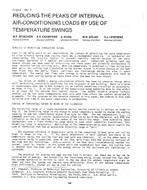Even in the early years of air conditioning, the concept of permitting the space temperature to climb slightly during peak cooling loads was a recommended practice. In residential air conditioning, the practice results in improved humidity control because of the morecontinuous operation of a smaller air–conditioning unit. Commercial buildings must pay demand charges for peak uses of electricity and these peaks are primarily attributable to power required for the chilling unit. When the temperature is permitted to climb during peak heat gains, the cooling load transferred to the thermal system is blunted because of the heat that flows into the walls, floors, ceilings, and furnishings during the rise in space temperature. The, energy that flows into storage in those building components must later be removed, but that cooling operation takes place after the peak has been passed.
The thrust of ASHRAE’s energy-conservation efforts has been to conserve energy while still maintaining comfortable conditions for the occupants of the building. There is a range of temperatures that the ASHRAE standard on comfort conditions classifies as acceptable, as shown in Fig. 1. It is the intent of the temperature-swing operating mode to stay within or at least not far outside this comfort region. The ASHRAE research program includes studies on how space temperatures that vary with time affect the comfort perceived by occupants. For the purposes of the research reported in this paper, the premise is that some variation with time of the space temperature is permissible.
The purpose of the studies reported in this paper is to explore the combined behavior of a conditioned space whose temperature varies under the control of a space thermostat with an intentionally large throtting range.
A companion objective of the studies is to provide experimental data that developers of large energy calculation programs can use to validate algorithms in their programs that calculate time-variant space temperatures and energy flow rates.
An important by-product of the studies and the entire concept of utilizing temperature swings is that if the cooling loads can be accurately calculated in the design stage, the first cost of the system can be reduced by virtue of smaller sizes of chillers, ducts, and fans.
Product Details
- Published:
- 1981
- Number of Pages:
- 10
- File Size:
- 1 file , 980 KB
- Product Code(s):
- D-CI-81-03-5
- Note:
- This product is unavailable in Russia, Belarus
